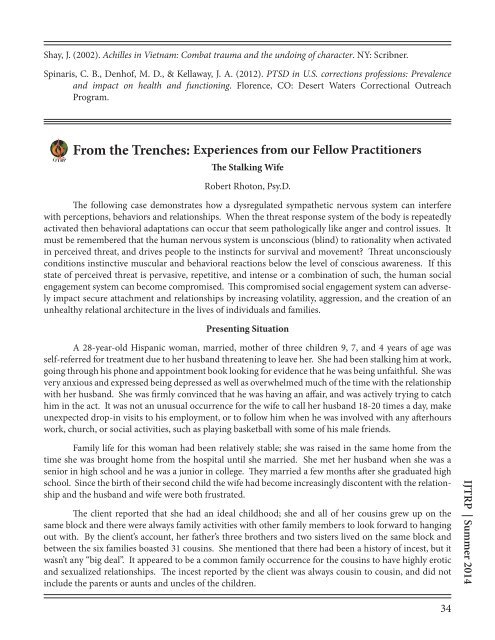International Journal of Trauma Research and Practice - Anger Study_0
International Journal of Trauma Research and Practice - Anger Study_0
International Journal of Trauma Research and Practice - Anger Study_0
Create successful ePaper yourself
Turn your PDF publications into a flip-book with our unique Google optimized e-Paper software.
Shay, J. (2002). Achilles in Vietnam: Combat trauma <strong>and</strong> the undoing <strong>of</strong> character. NY: Scribner.Spinaris, C. B., Denh<strong>of</strong>, M. D., & Kellaway, J. A. (2012). PTSD in U.S. corrections pr<strong>of</strong>essions: Prevalence<strong>and</strong> impact on health <strong>and</strong> functioning. Florence, CO: Desert Waters Correctional OutreachProgram.From the Trenches: Experiences from our Fellow PractitionersThe Stalking WifeRobert Rhoton, Psy.D.The following case demonstrates how a dysregulated sympathetic nervous system can interferewith perceptions, behaviors <strong>and</strong> relationships. When the threat response system <strong>of</strong> the body is repeatedlyactivated then behavioral adaptations can occur that seem pathologically like anger <strong>and</strong> control issues. Itmust be remembered that the human nervous system is unconscious (blind) to rationality when activatedin perceived threat, <strong>and</strong> drives people to the instincts for survival <strong>and</strong> movement? Threat unconsciouslyconditions instinctive muscular <strong>and</strong> behavioral reactions below the level <strong>of</strong> conscious awareness. If thisstate <strong>of</strong> perceived threat is pervasive, repetitive, <strong>and</strong> intense or a combination <strong>of</strong> such, the human socialengagement system can become compromised. This compromised social engagement system can adverselyimpact secure attachment <strong>and</strong> relationships by increasing volatility, aggression, <strong>and</strong> the creation <strong>of</strong> anunhealthy relational architecture in the lives <strong>of</strong> individuals <strong>and</strong> families.Presenting SituationA 28-year-old Hispanic woman, married, mother <strong>of</strong> three children 9, 7, <strong>and</strong> 4 years <strong>of</strong> age wasself-referred for treatment due to her husb<strong>and</strong> threatening to leave her. She had been stalking him at work,going through his phone <strong>and</strong> appointment book looking for evidence that he was being unfaithful. She wasvery anxious <strong>and</strong> expressed being depressed as well as overwhelmed much <strong>of</strong> the time with the relationshipwith her husb<strong>and</strong>. She was firmly convinced that he was having an affair, <strong>and</strong> was actively trying to catchhim in the act. It was not an unusual occurrence for the wife to call her husb<strong>and</strong> 18-20 times a day, makeunexpected drop-in visits to his employment, or to follow him when he was involved with any afterhourswork, church, or social activities, such as playing basketball with some <strong>of</strong> his male friends.Family life for this woman had been relatively stable; she was raised in the same home from thetime she was brought home from the hospital until she married. She met her husb<strong>and</strong> when she was asenior in high school <strong>and</strong> he was a junior in college. They married a few months after she graduated highschool. Since the birth <strong>of</strong> their second child the wife had become increasingly discontent with the relationship<strong>and</strong> the husb<strong>and</strong> <strong>and</strong> wife were both frustrated.The client reported that she had an ideal childhood; she <strong>and</strong> all <strong>of</strong> her cousins grew up on thesame block <strong>and</strong> there were always family activities with other family members to look forward to hangingout with. By the client’s account, her father’s three brothers <strong>and</strong> two sisters lived on the same block <strong>and</strong>between the six families boasted 31 cousins. She mentioned that there had been a history <strong>of</strong> incest, but itwasn’t any “big deal”. It appeared to be a common family occurrence for the cousins to have highly erotic<strong>and</strong> sexualized relationships. The incest reported by the client was always cousin to cousin, <strong>and</strong> did notinclude the parents or aunts <strong>and</strong> uncles <strong>of</strong> the children.IJTRP | Summer 201434


